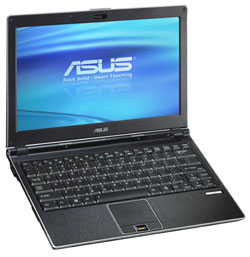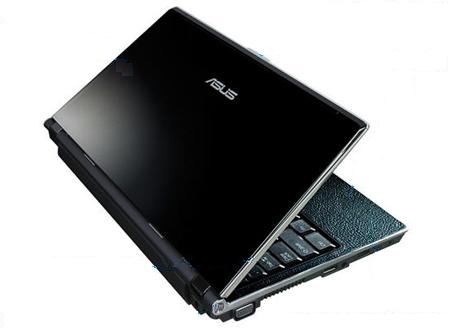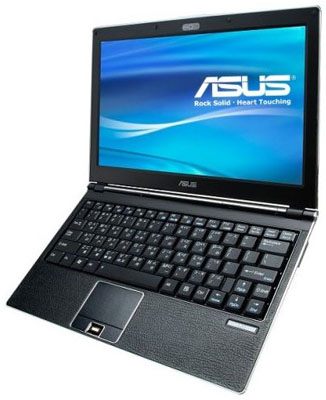New ASUS U1F Subnotebook - The Shape Of Things To Come In A Baby MacBook Pro?
by Charles W. Moore
Last weekend, PC-maker ASUS unveiled its latest laptop, the subcompact U1F, a decidedly upmarket entrant in the crowded Windows subnotebook category, complete with a lacquered “piano finish” and real hide leather palm rests. ASUS has experience and expertise in the fancy laptop category, with its lines of full-sized Lamborghini laptops.

That’s interesting, you might be saying, but what relevance does another Windows laptop have to the Apple ‘Book mystique? Well, possibly more than you might imagine. Since you’re reading this column, you’re probably aware that many Apple portable fans are eagerly hoping for, and the rumor mills ever more confidently anticipating, an Intel-powered replacement for the admirable 12-inch PowerBook, and it so happens that ASUS, aka Asustek, aka Asusalpha Computer (formerly AlphaTop), is one of Apple’s Taiwanese laptop subcontractors and engineering partners, and the main producer of MacBooks, as well as the original and dual-USB iBooks and the 12-inch PowerBook, which was heavily based on the iBook design.
Consequently, it doesn’t seem excessively fanciful that at least some of the clever engineering that has gone into the ASUS U1F laptop could very well find its way into the new Apple MacBook Pro subnotebook - and least if ASUStek is awarded the contract to build it for Apple, which seems likely based on precedent.
Now, I’m not suggesting that any new baby MacBook Pro will simply be a clone of this new ASUS machine. Any new subnotebook Apple can expected to be a product of Jonathan Ive and his design team in styling and form factor, and with a typically Apple feature set. However, Macs these days are essentially PCs, so a commonality of internal engineering would not be of of the question.
I’m also doubtful that Apple would want to shoot for the ASUS unit’s 2.2 pound weight, and the rumoristas are predicting something in the 3.5 pound range with a 12 inch widescreen as opposed to the U1F’s 11.1” display. Even 3.5 pounds would be more than a pound lighter than the erstwhile 12-inch PowerBook.
So let’s take a look at what ASUS has wrought with this new U1F laptop.
Adv: Compare notebook prices at www.pcprices.net/pc. Updated daily.
First, it’s a stylish little package - quite different from Apple’s notebook motif, but very attractive, IMHO. From publicity photos, the the lacquered “piano finished” screen lid, “stainless contour” styling accents, carbon fiber alloy housing, and pebble-grained genuine leather bound palm rests give the U1F, despite it’s diminutive size, a definite air of luxury and sophistication.

Under the hood things are perhaps not quite as flush, at least in the CPU department. The U1F is powered by an Intel U2400 1.06 GHz, 2MB L2 ultra-low voltage Core Duo with GMA 945 integrated graphics support (aka “vampire video”). This sounds a bit underwhelming now that we’re accustomed to 1.83 GHz Core 2 Duos in the most basic MacBook, but IMHO going with a lower-powered chip in this sort of machine makes a lot of sense in terms of keeping heat down to a simmer and extending battery life in road warrioring mode. A 1.06 GHz Core Duo isn’t going to knock anyone’s socks off, but it should be more than adequate for the sort of things most users will want to do with a subnotebook like this. Let’s face it, very few are going to want to do high-end graphics work, video editing, or serious gaming on an 11.1” display - however bright and sharp, so the integrated graphics should be adequate as well in this context.
My main production machine is still a 1.33 GHz G4 PowerBook and I’m not finding lack of processing grunt a particular incentive to upgrade systems so far. I think I could be very happy using a 1.06 GHz Core Duo, especially if it allowed the machine to run cooler, and without the cacophonous accompaniment of howling fans.
That said, Apple may want to stuff a Core 2 Duo (or Santa Rosa) CPU in the baby MacBook Pro, which will probably, as noted, be somewhat larger in form factor than the ASUS U1F.
Other internal specs. for the U1F are respectable, if middle to low end in a contemporaneous context - 667 MHz of standard RAM, 40, 60, and 80 GB hard drives, and a satisfyingly comprehensive array of I/O ports, including 4 USB 2.0 ports, one FireWire 400 port, a VGA port to run external displays, one New Card port, 1x 5V DC-out port, and an optional USB Portbar. I especially like the multiplicity of USB 2 ports, unmatched by any Apple notebook.
The Asus press release, presumably written by someone for whom English is not their first language, notes that “the LCD cover is high in hardness for enhanced screen protection,” which probably references the use of carbon fiber. The case is described as of magnesium-aluminum alloy, which provides rigidity and ruggedness with light weight, which in this instance is a feather-like 2.2 pounds or less than 1 kilogram, and measures a svelte 10.8” x 7.5” x 0.7”-1.1”.
This admirably low weight, which should make the U1F a joy to pack around, is also partly attributable to the computer display’s LED backlight panel, which is half the width of and 1/3 lighter than a traditional LCD-illuminated screen, and also operates with lower power consumption and offers better luminance as well as faster response time. In addition, the 11.1-inch WXGA glossy widescreen with what ASUS calls a “Splendid Color Enhancement Engine” is claimed to produce vivid colors and sharp details. Sounds delightful. The scuttlebutt is that Apple’s subnotebook will have a 12” widescreen, which would of course make it bigger and heavier than the U1F, but arguably a better movie-watching device, but it is expected that its display will be LED backlit.
One ASUS U1F feature that may not make it into the MacBook Pro is a built-in fingerprint scanner that reads from the live layer of skin, preventing common skin surface conditions from impairing scanner accuracy. More necessary for a Windows box than a Mac OS machine is an embedded TPM hardware solution that ASUS says prevents attacks by hackers looking to capture passwords and encryption keys to sensitive data.

An analog to Apple’s iSight camera, the U1F includes a 300,000-pixel webcam module in its LCD panel. T, which together with a built-in high quality microphone, makes wireless video conferencing is possible anywhere you have WiFi access. Speaking of which, the U1F supports built-in WLAN 802.11 a/b/g and Bluetooth 2.0 enhanced data rate.
There has been considerable speculation that Apple will have to dispense with an internal optical drive in order to get the baby MacBook Pro’s weight down to the 3.5 pound range, and indeed that is the tack ASUS has taken with the U1F, which has no built-in optical drive, but is available with an optional external Blu-Ray/DVD Super Multi DL/Combo drive. This is probably the most sensible solution for a laptop this small, and recalls the motif of the Apple PowerBook 2400c and the original PowerBook 100, both of which had external floppy drive modules.
Of course, a big downside with the ASUS U1F, as with all non-Apple notebooks, is that you can’t run the Mac OS. It supports Vista, with all the DRM blocks, product activation hassles, and general Microsoft sleaziness and bugginess that goes with. Check out these recent Forbes commentaries:
http://www.forbes.com/free_forbes/2007/0226/050.html
However, ASUS has done a nice job with the U1F, within the limitations of the Windows orbit, and if Apple can (perhaps in partnership with ASUS engineering, come up with something as cool in a thoroughly Mac motif, it should be an out-of-the-park home run.
I wasn’t able to suss out a suggested retail price for the ASUS U1F, but my guess would be that it and the baby MacBook Pro will be in the same ballpark there.
For more information, visit:
http://usa.asus.com/news_show.aspx?id=6130
or
http://usa.asus.com/
or
http://ca.asus.com/
Visit the MacBook Price Trackers at PCPrices/Mac for the best deals and lowest prices on a new MacBook or MacBook Pro.
Note: Letters to 'Book Mystique Mailbag may or may not be published at the editor's discretion. Correspondents' email addresses will NOT be published unless the correspondent specifically requests publication. Letters may be edited for length and/or context.
Opinions expressed in postings to PowerBook Mystique MailBag are owned by the respective correspondents and not necessarily shared or endorsed by the Editor and/or PowerBook Central management.
If you would prefer that your message not appear in PowerBook Mystique Mailbag, we would still like to hear from you. Just clearly mark your message "NOT FOR PUBLICATION," and it will not be published.
CM